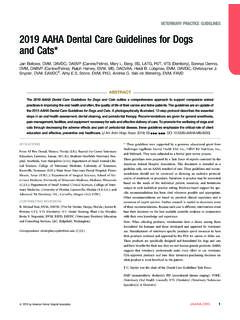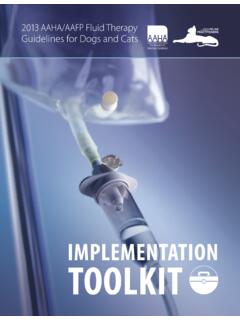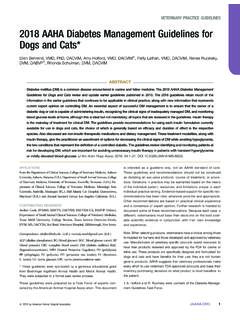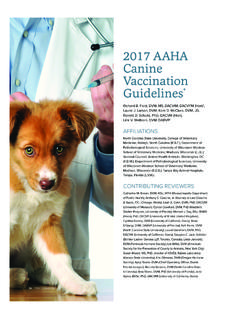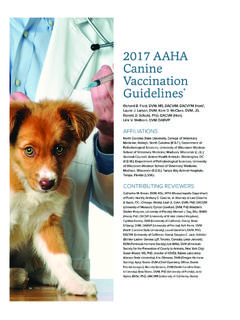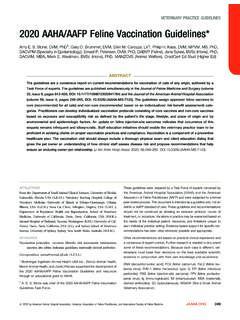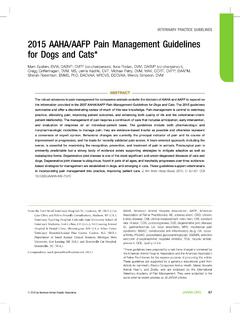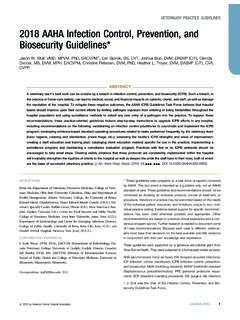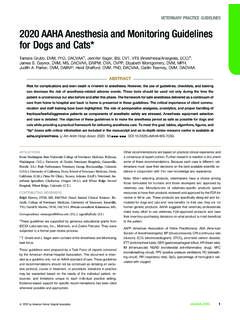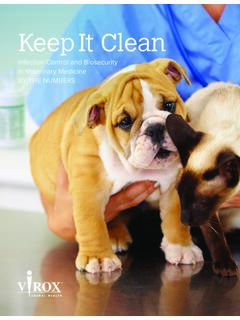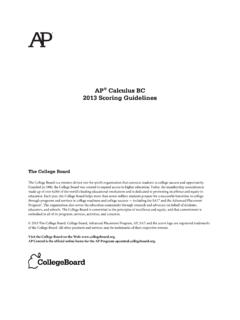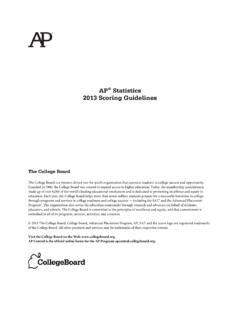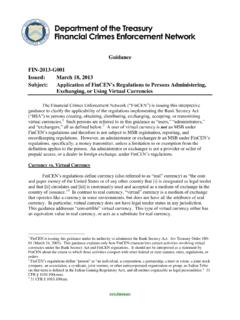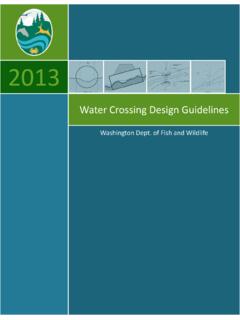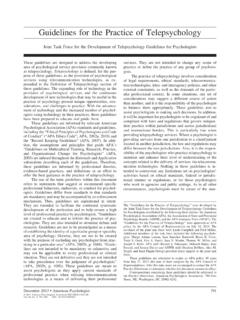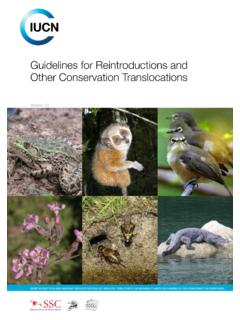Transcription of 2013 AAHA/AAFP Fluid Therapy Guidelines for Dogs and Cats*
1 VETERINARY PRACTICE GUIDELINES2013 AAHA/AAFP Fluid Therapy Guidelines forDogs and Cats* Harold Davis, BA, RVT, VTS (ECC), Tracey Jensen, DVM, DABVP, Anthony Johnson, DVM, DACVECC,Pamela Knowles, CVT, VTS (ECC), Robert Meyer, DVM, DACVAA, Renee Rucinsky, DVM, DAVBP (Feline),Heidi Shafford, DVM, PhD, DACVAAABSTRACTF luid Therapy is important for many medical conditions in veterinary patients. The assessment of patient history, chief complaint,physical examfindings, and indicated additional testing will determine the need forfluid Therapy . Fluid selection is dictated by thepatient s needs, including volume, rate, Fluid composition required, and location thefluid is needed ( , interstitial versusintravascular). Therapy must be individualized, tailored to each patient, and constantly re-evaluated and reformulated accordingto changes in status.
2 Needs may vary according to the existence of either acute or chronic conditions, patient pathology ( ,acid-base, oncotic, electrolyte abnormalities), and comorbid conditions. All patients should be assessed for three types offluiddisturbances: changes in volume, changes in content, and/or changes in distribution. The goals of these Guidelines are to assistthe clinician in prioritizing goals, selecting appropriatefluids and rates of administration, and assessing patient response totherapy. These Guidelines provide recommendations forfluid administration for anesthetized patients and patients withfluiddisturbances.(JAmAnimHospAssoc2 013; 49:149 159. DOI )IntroductionTheseguidelineswillprovidep racticalrecommendationsforfluid choice, rate, and route of administration.
3 They are or-ganized by general considerations, followed by specificguide-lines for perianestheticfluid Therapy and for treatment ofpatients with alterations in bodyfluid volume, changes in bodyfluidcontent, and abnormal distribution offluid within the body. Pleasenote that these Guidelines are neither standards of care nor AmericanAnimal Hospital Association (AAHA) accreditation standards andshould not be considered minimum Guidelines . Instead theseguidelines are recommendations from an AAHA/American Asso-ciation of Feline Practitioners (AAFP) panel of must be individualized and tailored to each patientand constantly re-evaluated and reformulated according to changesin status. Fluid selection is dictated by the patient s needs, in-cluding volume, rate, andfluid composition required, as well aslocation thefluid is needed (interstitial versus intravascular).
4 Factors to consider include the following:From the University of California Davis, Veterinary Medical Teach-ing Hospital, Davis, CA ( ); Wellington Veterinary Clinic, PC,Wellington, CO ( ); Department of Veterinary Clinical Sciences,College of Veterinary Medicine, Purdue University, West Lafayette,IN ( ); WestVet Animal Emergency and Specialty Center, GardenCity, ID ( ); Mississippi State University College of VeterinaryMedicine, Mississippi State, MS ( ); Mid Atlantic Cat Hospital,Cordova, MD ( ); and Veterinary Anesthesia Specialists, LLC,Milwaukie, OR ( ).Correspondence: ( ) and ( )AAFPA merican Association of Feline Practitioners;AAHAA merican AnimalHospital Association;BPblood pressure;D5W5% dextrose in water;DKAdiabetic ketoacidosis;Kpotassium;KClpotassium chloride;LRSlactatedRinger s solution*This document is intended as a guideline only.
5 Evidence-based supportfor specific recommendations has been cited whenever possible andappropriate. Other recommendations are based on practical clinical ex-perience and a consensus of expert opinion. Further research is neededto document some of these recommendations. Because each case isdifferent, veterinarians must base their decisions and actions on the bestavailable scientific evidence, in conjunction with their own expertise, knowl-edge, and experience. These Guidelines are supported by a generous edu-cational grant from Abbott Animal Health. 2013 by American Animal Hospital Acute versus chronic conditions Patient pathology ( , acid-base balance, oncotic pressure,electrolyte abnormalities) Comorbid conditionsA variety of conditions can be effectively managed using threetypes offluids: a balanced isotonic electrolyte ( , a crystalloidsuch as lactated Ringer s solution [LRS]); a hypotonic solution ( ,a crystalloid such as 5% dextrose in water [D5W]); and a syntheticcolloid ( , a hydroxyethyl starch such as hetastarch or tetrastarch).
6 General Principles and Patient AssessmentThe assessment of patient history, chief complaint, and physicalexamfindings will determine the need for additional testingandfluid Therapy . Assess for the following three types offluiddisturbances:1. Changes in volume ( , dehydration, blood loss)2. Changes in content ( , hyperkalemia)3. Changes in distribution ( , pleural effusion)The initial assessment includes evaluation of hydration, tissueperfusion, andfluid volume/loss. Items of particular importance inevaluating the need forfluids are described inTable 1. Next,develop a treatment plan byfirst determining the appropriateroute offluid administration. Guidelines for route of adminis-tration are shown inTable the temperature of thefluids.
7 Body temperature(warmed)fluids are useful for large volume resuscitation butprovide limited usefulness at low IV infusion rates. It is not possibleto provide sufficient heat via IVfluids at limited infusion rates toeither meet or exceed heat losses for Maintenance and ReplacementWhether administered either during anesthesia or to a sick patient, Fluid Therapy often begins with themaintenance rate,which is theamount offluid estimated to maintain normal patientfluid bal-ance (Table 3). Urine production constitutes the majority offluidloss in healthy ,3 Maintenancefluid Therapy is indicatedfor patients that are not eating or drinking, but do not havevolume depletion, hypotension, or ongoing ( , LRS) are intended to replace lostbodyfluids and electrolytes.
8 Isotonic polyionic replacementcrystalloids such as LRS may be used as either replacement or asmaintenancefluids. Using replacement solutions for short-termmaintenancefluid Therapy typically does not alter electrolytebalance; however, electrolyte imbalances can occur in patients withrenal disease or in those receiving long-term administration ofreplacement solutions for replacement solutions such as LRS for main-tenance predisposes the patient to hypernatremia and hypokalemiabecause these solutions contain more sodium (Na) and less po-tassium (K) than the patient normally loses. Well-hydrated patientswith normal renal function are typically able to excrete excess Naand thus do not develop hypernatremia. Hypokalemia may developin patients that receive replacement solutions for maintenancefluid Therapy if they are either anorexic or have vomiting or di-arrhea because the kidneys do not conserve K very using a replacement crystalloid solution for maintenancetherapy, monitor serum electrolytes periodically ( ,q24 hr).
9 Maintenance crystalloid solutions are commercially , Fluid made up of equal volumes of replacementsolution and D5W supplemented with K ( , potassium chloride[KCl], 13 20 mmol/L, which is equivalent to 13 20 mEq/L) wouldbe ideal for replacing normal ongoing losses because of the lowerNa and higher K concentration. Another option for a maintenancefluid solution is to use sodium chloride with 13 20 mmol/LKCl resources regardingfluid Therapy and typesoffluids are available on the AAHA and AAFP and AnesthesiaOne of the most common uses offluid Therapy is for patientsupport during the perianesthetic period. Decisions regardingwhether to providefluids during anesthesia and the type andvolume used depend on many factors, including the patient ssignalment, physical condition, and the length and type of theprocedure.
10 Advantages of providing perianestheticfluid therapyfor healthy animalsinclude the following: Correction of normal ongoingfluid losses, support of cardio-vascular function, and ability to maintain whole bodyfluidvolume during long anesthetic periods Countering of potential negative physiologic effects associatedwith the anesthetic agents ( , hypotension, vasodilation)TABLE 1 Evaluation and Monitoring Parameters that May Be Used forPatients Receiving Fluid Therapy Pulse rate and quality Packed cell volume/total solids Capillary refill time Total protein Mucous membrane color Serum lactate Respiratory rate and effort Urine specific gravity Lung sounds Blood urea nitrogen Skin turgor Creatinine Body weight Electrolytes Urine output BP Mental status Venous or arterial blood gases Extremity temperature O2saturationBP, blood |49.
